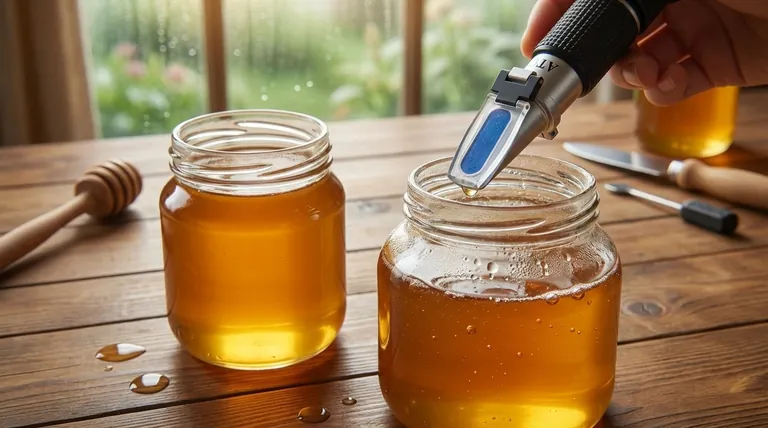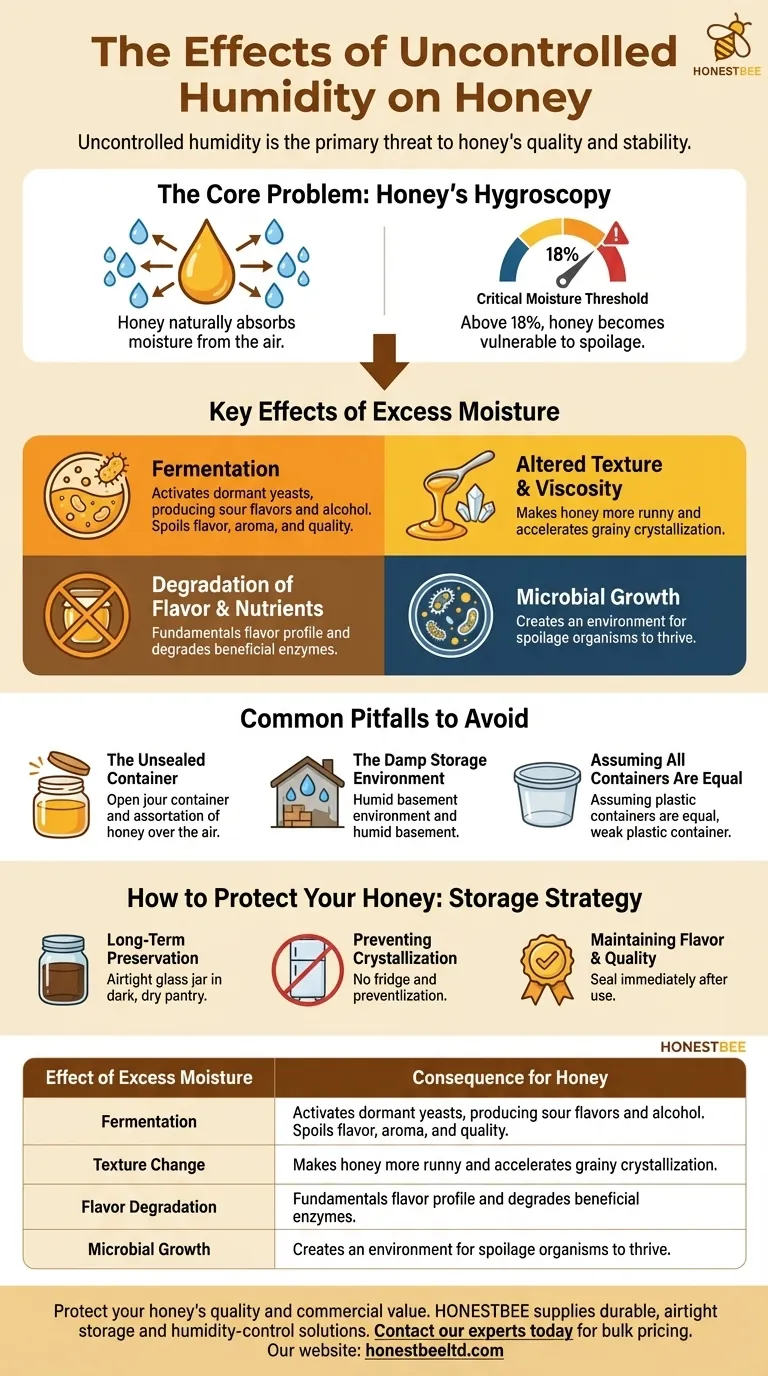Uncontrolled humidity is the primary threat to honey's quality and stability. Because honey is a hygroscopic substance, it naturally absorbs moisture from the air. When its water content rises above a critical threshold, it triggers a cascade of negative effects, including fermentation, microbial growth, and degradation of its unique texture and flavor.
The core problem is simple: excess moisture activates dormant yeasts naturally present in honey. This initiates fermentation, which spoils the honey's flavor, aroma, and chemical composition, effectively ruining its quality and drastically reducing its shelf life.

The Core Problem: Why Honey Is Vulnerable
Honey's relationship with water is the key to understanding its stability. Its low natural water content and high sugar concentration create an environment where microorganisms cannot thrive.
Understanding Hygroscopy
Honey is hygroscopic, meaning it actively draws in and holds water molecules from the surrounding atmosphere. This is why an unsealed jar of honey in a humid room will gradually become more fluid over time.
The Critical Moisture Threshold
Properly cured honey typically has a water content below 18%. This low moisture level is what makes it so shelf-stable. Once the moisture level rises above this point, the environment becomes hospitable for spoilage organisms.
Key Effects of Excess Moisture on Honey
When honey absorbs too much water, its fundamental properties begin to break down, leading to several observable changes.
Fermentation and Microbial Growth
All raw honey contains small amounts of wild yeasts. In dry honey, these yeasts are dormant and harmless. When excess moisture is introduced, these yeasts become active and begin to metabolize the honey's sugars, a process known as fermentation. This is similar to how mead is made, but in this context, it is considered spoilage.
Altered Texture and Viscosity
Increased water content makes honey more runny and less viscous. This change in consistency can be undesirable for consumers and can affect its use in recipes. Paradoxically, excess moisture can also accelerate crystallization, altering its smooth texture into a grainy one.
Degradation of Flavor and Nutrients
Fermentation produces acids and other byproducts that fundamentally alter the honey's delicate flavor profile, often making it sour or "off." This microbial activity can also degrade the beneficial enzymes and nutrients that contribute to honey's quality.
Common Pitfalls to Avoid
Protecting honey from humidity is straightforward, but a few common mistakes can easily compromise a batch.
The Unsealed Container
The most frequent error is failing to seal the container tightly. An airtight lid is the primary defense against ambient humidity, preventing the honey from constantly absorbing moisture from the air.
The Damp Storage Environment
Storing honey in a humid environment, such as a damp basement or directly next to a steamy kitchen area, increases the risk of moisture contamination every time the container is opened.
Assuming All Containers Are Equal
Not all containers are truly airtight. Using high-quality glass jars with tight-fitting lids is crucial. Flimsy plastic containers or decorative jars with loose corks are inadequate for long-term storage.
How to Protect Your Honey
Your storage strategy should be guided by your primary goal, whether it's long-term preservation or immediate use.
- If your primary focus is long-term preservation: Store honey in a tightly sealed, airtight glass container in a cool, dark, and—most importantly—dry pantry.
- If your primary focus is preventing crystallization: Avoid storing honey in the refrigerator, as cool temperatures accelerate the crystallization process.
- If your primary focus is maintaining flavor and quality: Minimize the honey's exposure to air by sealing the container immediately after every use.
Proper storage is not just about preventing spoilage; it's about preserving the unique character and quality that makes honey a valuable product.
Summary Table:
| Effect of Excess Moisture | Consequence for Honey |
|---|---|
| Fermentation | Activates natural yeasts, producing sour flavors and alcohol. |
| Texture Change | Increases runniness and can accelerate grainy crystallization. |
| Flavor Degradation | Alters delicate aroma and taste profile, reducing quality. |
| Microbial Growth | Creates an environment for spoilage organisms to thrive. |
Protect your honey's quality and commercial value with the right equipment. Uncontrolled humidity is a major risk for commercial apiaries and distributors, leading to product loss and reduced shelf life. HONESTBEE supplies durable, airtight storage solutions and professional beekeeping equipment designed specifically for wholesale operations. Ensure your honey maintains its perfect viscosity, flavor, and marketability. Contact our experts today to discuss bulk pricing and humidity-control solutions tailored to your scale.
Visual Guide

Related Products
- Precision Honey Refractometer Instrument for Quality Assessment
- Professional Thermostatic Conical Honey Melter
- Inverted Squeezable Honey Jar with No Drip Flip Top Cap for Easy Pouring
- Professional Cone-Shaped Honey Filter with Reinforced Steel Ring
- 0.5T Capacity Honey Dehumidifier Dryer with Vacuum Heating and Thickening Filtering Machine
People Also Ask
- Why is a honey refractometer essential for honey harvesting? Protect Your Harvest from Spoilage
- What is a honey refractometer and what is its purpose? Ensure Honey Quality and Prevent Spoilage
- What is a honey refractometer? The Essential Tool for Perfect Honey Quality
- How does a honey refractometer work? Ensure Honey Quality & Harvest Readiness
- Why is a honey refractometer important for beekeepers? Ensure Quality and Prevent Fermentation



















